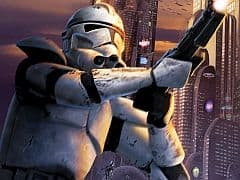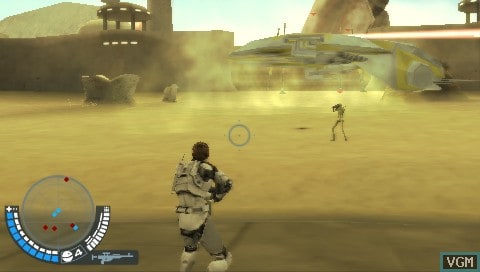You can trust VideoGamer. Our team of gaming experts spend hours testing and reviewing the latest games, to ensure you're reading the most comprehensive guide possible. Rest assured, all imagery and advice is unique and original. Check out how we test and review games here
In principle, it’s hard not to be impressed by the scale of the action in Star Wars Battlefront: Elite Squadron. At the start of a battle you might be fighting on the surface of a planet, but if you hop into an X-Wing, or another spacecraft of your choice, you can head into space for a spot of zero-gravity dogfighting. If you’ve managed to knock out the defenses on one of the massive Capital Ships, you can then dock with them and explore their insides on foot. Force your way through to the reactor core, and you can start a chain reaction that will destroy the entire vessel; if you manage to escape in time, you can then use your ship to fly back down to solid ground, where the struggle will continue.
If you were to travel back in time and tell a six-year-old version of me that I’d eventually be doing this kind of thing in a video game, alongside up to 15 other gamers, while playing on a handheld console… well, I’d probably spill Capri Sun down my Ninja Turtles T-shirt. It’s already a pretty ambitious goal to make the Battlefront format work on the PSP, but by extending the scale of its online multiplayer battles developer Rebellion has really tried to push the envelope as far as it can go. Unfortunately, you need more than just raw ambition to make an idea work. At the age of six, I’d already learned this lesson the hard way: I once planned to make my own spaceship from scratch, but after weeks of collecting random metal junk, I poked myself in the eye with the end of a rusty rake. The project rather floundered after that.
Rebellion hasn’t fallen quite so far short of its lofty target, but it certainly hasn’t nailed the job either. As was the case with their last PSP Battlefront game – the similarly-named Renegade Squadron – the key draw here is the chance to engage in large multiplayer scraps set at key Star Wars locations, with up to eight players on each side. There are four match types to try: Two variants of Capture the Flag; a control point-based game called Conquest; and Heroes and Villains – a team deathmatch mode featuring Star Wars celebs. Some of these conflicts take place during the Empire versus Rebels era of the original film trilogy, while others are set during the Republic versus Confederacy period of the prequels, but it all amounts to the same thing: Pick a class – either one of the four pre-set loadouts, or a customised one of your own design – and then get stuck into the action.
It’s been two years since the release of Renegade Squadron, but sadly Rebellion’s follow-up has inherited many of its predecessor’s problems. The chief problem is the game’s control scheme, particularly its total reliance upon the analogue nub. By now most gamers are used to using a twin analogue stick setup for their console shooting; regardless of whether you’re playing from a first or third-person perspective, one stick will govern your movement while the other controls your aim. Here you’re forced to use the nub to steer yourself about, while a lock-on button (the right bumper) attempts to make up for the lack of free-flow aiming. It’s not a bad idea under the circumstances, but in practice it totally fails. You can use the d-pad to flick between targets, but if you need to do this quickly then you’re almost certain to wind up in trouble. If you happen to aim at a large or elevated target, like an enemy vehicle, you can end up walking around with your eyes glued to the sky; to correct your perspective you’ll have to lock onto something else, but you’ll usually be killed before you get a chance to do this.
To make matters worse, you can only strafe while holding the aim/lock-on button, so it’s impossible to turn and strafe at the same time – a manoeuvre that’s usually essential in this type of game. Movement is generally awkward, especially if you’re inside a Capital Ship or some other confined space. Under such circumstances the camera will often zoom in to a sort of cheated FPS view, but it can still be hard to get a handle on your movements. A similar problem kicks in when you’re in the cockpit of a large vehicle like an AT-ST, which clearly limits the fun-factor of being inside a bipedal pillar of death.
To give credit where it’s due, it’s undeniably cool that Elite Squadron’s matches unfold over three separate planes at once. Conquest matches tend to start with a rabid scrap to capture the Ion Cannon, a planetside control point that grants access to a hugely powerful weapon. Once this is charged, it can be fired at an orbiting Capital Ship, lowering the defences and allowing your allies in space to stage an invasion. It’s important to note that that the three battlefronts – planet, space, and craft interior – exist as separate areas; every time you pass from one to the other you’ll have to sit through a short transition video. Still, these pauses are bearable, and you’ll probably get quite a buzz the first time you enter space. Unfortunately, there’s actually not that much to do out there other than to shoot down enemy fighters – and since combat essentially amounts to holding down the auto-lock button, before unleashing a missile or barrage of fire, you won’t want to spend much time in your craft.
In addition to the main multiplayer variants, there’s a curious board game-style mode called Galactic Conquest. This is essentially Risk in all but name, with two rival factions attempting to seize intergalactic territory from each other. One player has their turn to purchase troops, attack or conquer planets and then reinforce their positions, and then play passes to the opposing side. It’s an odd accompaniment to the main game, but it’s executed well – with opportunities to spend resources on improving the stats of your troops, or on hero characters to lead your forces into battle. However, since this mode is limited to offline play with another human, it’s unlikely to take up much of your time.
Aside from Galactic Conquest, the main alternative to online play is Elite Squadron’s single-player campaign. Here you take on the role of X2, a special clone warrior infused with Jedi DNA to make him extra saucy. Together with his brother, X1, it’s X2’s job to train the Republic’s forces while undertaking special assignments. At the start of the story everything is hunky-dory, but naturally it doesn’t take long before the butt sausage hits the ventilation system. It’s a pretty ridiculous concept – why doesn’t the Republic make a whole army of X-troopers? But on the plus side, this setup allows Rebellion to create a story that spans both trilogies, and beyond.
The war-between-siblings plot actually works quite well in its own right, provided you can stomach yet another story about supposedly important characters who we’ve never heard of before. The between-level cutscenes re-use footage from the movies, and many of the stages are set during pivotal Star Wars events – including the battles at Hoth, Yavin and Endor. Progress in the single-player campaign is also used to unlock weapons and customisation options for the multiplayer side of things, but since you spend the majority of your time doing the whole Ion Cannon-Space-Capital Ship cycle, you’ll probably get bored quite quickly.
Indeed, that criticism could be applied to Elite Squadron as a whole. Yes, there are lots of unlocks, and medals to be won for completing specific challenges, but its core action is extremely samey. The standard character classes feel far too close to each other, so there’s none of the variety of, say, LOTR: Conquest. The Hero and Villain classes are slightly more interesting, but lightsaber combat is limited by the range of moves you can pull off. There’s something vaguely entertaining about watching Chewbacca mow down Darth Vader with his bowcaster, but the novelty of this sight soon wears off, and in general the Hero and Villain matches are far less dynamic than their Conquest and CTF counterparts.
On the audio front there’s the usual selection of official sound effects and John Williams music, but by now I’m guessing that most of us are used to these touches. Call me a bitter old man, but for some reason I no longer get a buzz from hearing kosher lightsaber noises or the “da-da-dadada, da-da-dadada” bit from Duel of the Fates. Still, the audio work here largely does its job well. The same can’t really be said for the game’s graphics, which at times seem to have been culled from a mid-range PS1 release. Yoda’s sprint animation is particularly embarrassing: I’m guessing he’s supposed to be bouncing about like that bit in Attack of the Clones, but in reality he looks like he’s some form of mystical flying drunk, yo-yoing up and down as he lurches forward.
Personally, I’m a bit mystified about why this game even exists. The concept behind the Star Wars Battlefront games is sound, but I can’t see why anyone would think that the PSP could be a good platform for this kind of outing. Even if you leave aside the graphical issues and other technical limitations, the lack of a second stick means you’re invariably going to have a nightmare with the controls – and in a twitch game like this, that’s simply not acceptable. This series absolutely deserves another home console incarnation, but since Free Radical’s Battlefront 3 “became one with The Force”, it’s hard to say when we’ll see one. In the meantime, I can only recommend that you re-watch the films or go back to the older Star Wars titles. To paraphrase Obi-Wan, this isn’t the game you’re looking for.
Star Wars Battlefront: Elite Squadron
- Platform(s): Nintendo DS, PSP
- Genre(s): Action, Shooter

/https://oimg.videogamer.com/images/ed17/sw_battlefront_elite_squadron_11.jpg)
/https://oimg.videogamer.com/images/bfc6/sw_battlefront_elite_squadron_15.jpg)
/https://oimg.videogamer.com/images/4f7a/sw_battlefront_elite_squadron_12.jpg)






